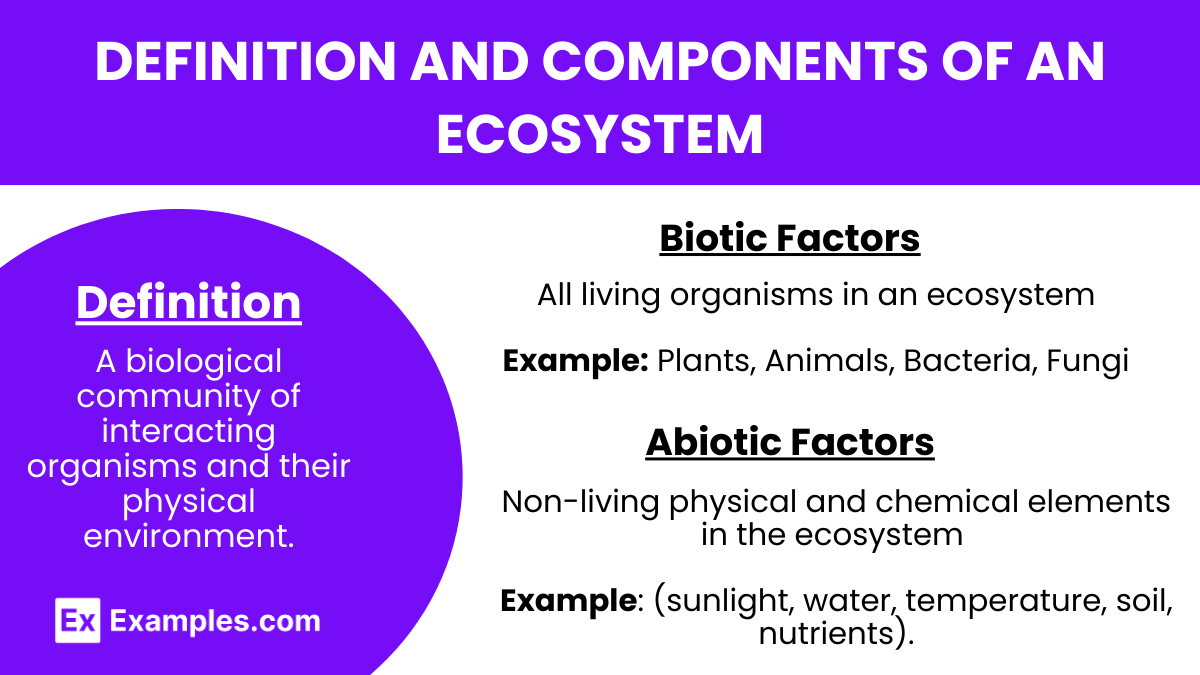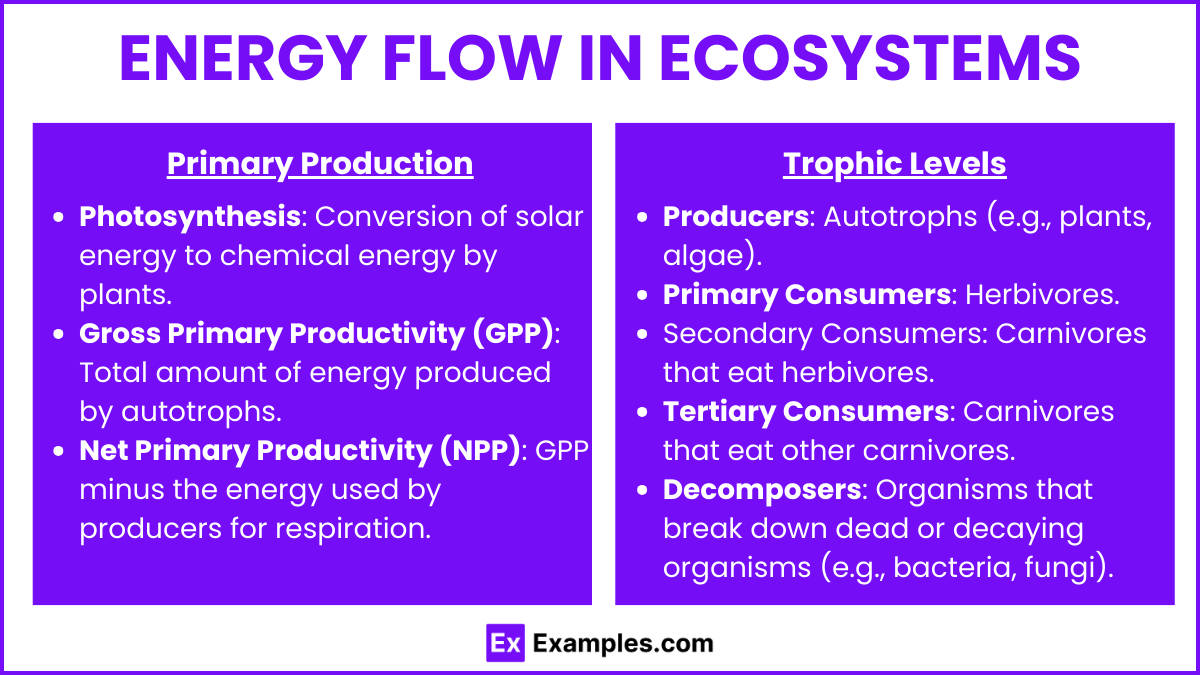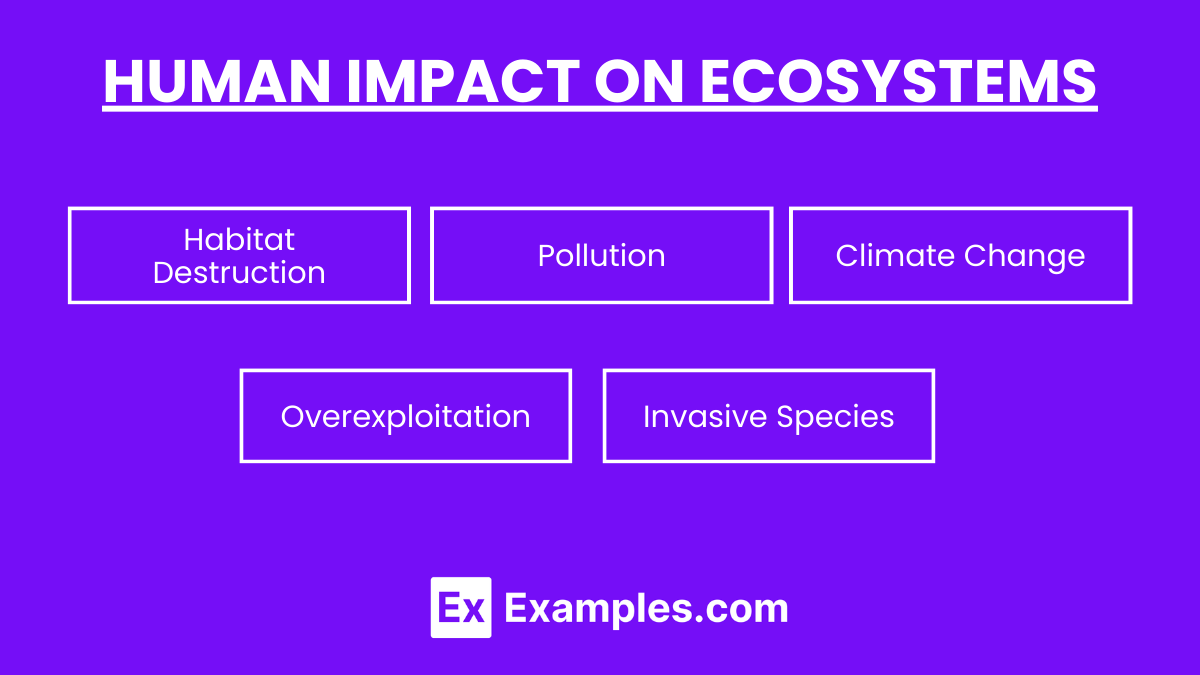An ecosystem is a complex network of biotic (living) and abiotic (non-living) components that interact in a specific environment, ranging from terrestrial (forests, grasslands, deserts, tundras) to aquatic (freshwater and marine) systems. These interactions include the flow of energy through food chains and food webs, nutrient cycling through biogeochemical processes, and population dynamics shaped by various ecological relationships such as predation, competition, and symbiosis. Human activities significantly impact ecosystems through habitat destruction, pollution, climate change, overexploitation, and the introduction of invasive species, necessitating efforts in conservation and sustainable practices to maintain ecological balance and biodiversity.
Learning Objectives
By studying ecosystems, students should aim to understand the intricate interactions between biotic and abiotic components that define different ecosystems, comprehend the flow of energy and cycling of nutrients through ecological processes, recognize the factors influencing population dynamics and community structure, and appreciate the impact of human activities on natural systems. Additionally, students should develop the ability to analyze ecological data, understand the principles of conservation biology, and explore sustainable practices that support ecosystem health and biodiversity. These learning objectives will provide a comprehensive foundation for appreciating and addressing ecological challenges.
Definition and Components of an Ecosystem

- Ecosystem: A biological community of interacting organisms and their physical environment.
- Components:
- Biotic Factors: All living organisms in an ecosystem (plants, animals, bacteria, fungi).
- Abiotic Factors: Non-living physical and chemical elements in the ecosystem (sunlight, water, temperature, soil, nutrients).
Types of Ecosystems

- Terrestrial Ecosystems:
- Forests: Tropical, temperate, boreal.
- Grasslands: Savannas, temperate grasslands.
- Deserts: Hot and cold deserts.
- Tundra: Arctic and alpine.
- Aquatic Ecosystems:
- Freshwater: Lakes, rivers, ponds, streams.
- Marine: Oceans, coral reefs, estuaries.
Energy Flow in Ecosystems

- Primary Production:
- Photosynthesis: Conversion of solar energy to chemical energy by plants.
- Gross Primary Productivity (GPP): Total amount of energy produced by autotrophs.
- Net Primary Productivity (NPP): GPP minus the energy used by producers for respiration.
- Trophic Levels:
- Producers: Autotrophs (e.g., plants, algae).
- Primary Consumers: Herbivores.
- Secondary Consumers: Carnivores that eat herbivores.
- Tertiary Consumers: Carnivores that eat other carnivores.
- Decomposers: Organisms that break down dead or decaying organisms (e.g., bacteria, fungi).
Nutrient Cycling in Ecosystems
- Biogeochemical Cycles:
- Water Cycle: Evaporation, condensation, precipitation, infiltration, runoff.
- Carbon Cycle: Photosynthesis, respiration, decomposition, fossil fuel combustion.
- Nitrogen Cycle: Nitrogen fixation, nitrification, assimilation, ammonification, denitrification.
- Phosphorus Cycle: Weathering of rocks, uptake by plants, movement through the food web, return to soil via decomposition.
Population Ecology
- Population Dynamics: Study of how populations change over time.
- Growth Models: Exponential growth (J-shaped curve), logistic growth (S-shaped curve).
- Carrying Capacity (K): Maximum population size an environment can support.
- Factors Affecting Population Size: Birth rates, death rates, immigration, emigration.
- Population Interactions:
- Competition: Interspecific and intraspecific competition for resources.
- Predation: Predator-prey relationships and their impact on population dynamics.
- Symbiosis: Mutualism, commensalism, parasitism.
Community Ecology
- Community Structure: The composition and arrangement of species within a community.
- Species Richness: Number of different species in a community.
- Species Evenness: Relative abundance of each species.
- Diversity Indices: Measures of biodiversity (e.g., Shannon index).
- Ecological Niches:
- Fundamental Niche: The full range of environmental conditions a species can occupy.
- Realized Niche: The actual conditions and resources a species uses.
- Succession:
- Primary Succession: Colonization of new sites by communities of organisms (e.g., after a volcanic eruption).
- Secondary Succession: Reestablishment of a damaged ecosystem where soil remains (e.g., after a fire).
Human Impact on Ecosystems

- Anthropogenic Effects:
- Habitat Destruction: Deforestation, urbanization, agriculture.
- Pollution: Air, water, soil pollution from industrial and agricultural activities.
- Climate Change: Global warming, changing weather patterns due to greenhouse gas emissions.
- Overexploitation: Overfishing, hunting, harvesting of resources beyond sustainable levels.
- Invasive Species: Non-native species introduced to new environments, often outcompeting native species.
Conservation Ecology
- Biodiversity Conservation:
- In-situ Conservation: Protecting species in their natural habitats (e.g., national parks, wildlife reserves).
- Ex-situ Conservation: Protecting species by removing part of the population from a threatened habitat and placing it in a new location (e.g., zoos, botanical gardens).
- Restoration Ecology: The scientific study and practice of renewing and restoring degraded, damaged, or destroyed ecosystems and habitats.
- Sustainable Practices: Methods of using resources that do not deplete them (e.g., sustainable agriculture, forestry, fishing).


